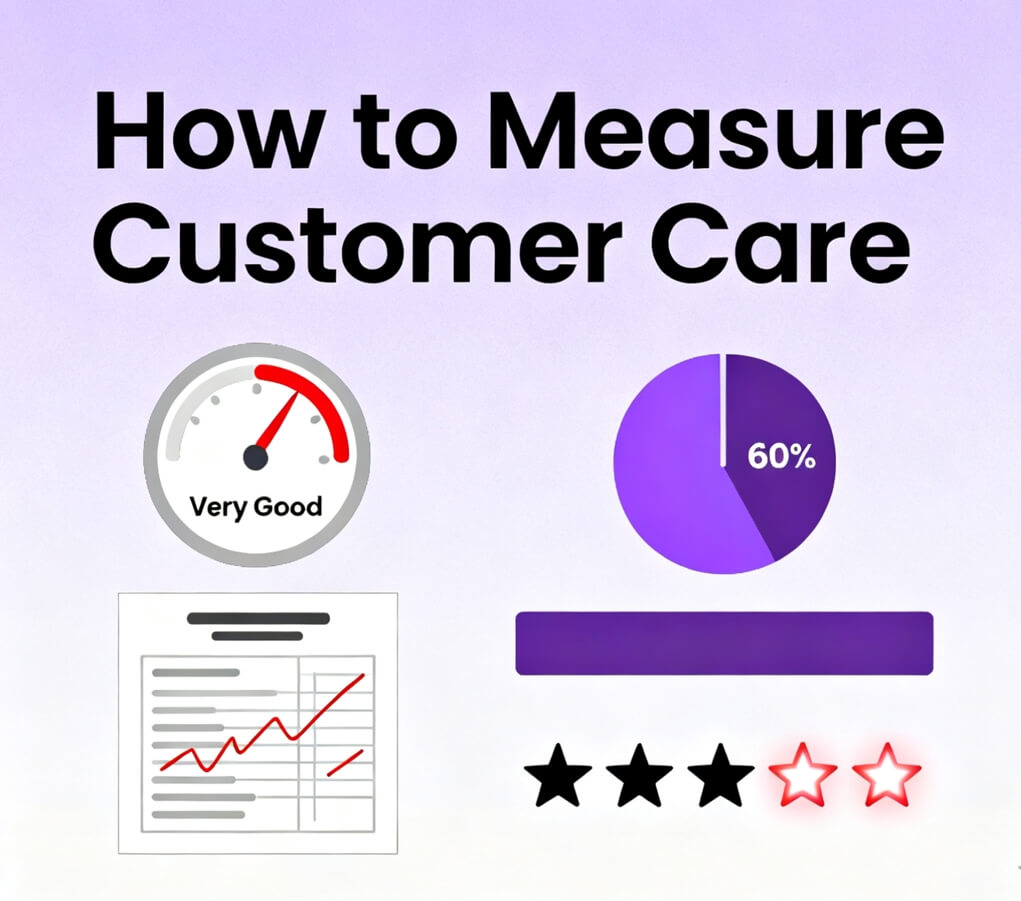Customer care is a way of treating customers with respect and kindness to make them feel valued. This has a profound and lasting impact on the success of a business. Research from DemandSage found that 96% of customers consider customer care as crucial, and 1% increase in satisfaction can boost 5% of customer retention. Tools like Solvea help businesses deliver human-like customer care, improving customer satisfaction and reducing operational costs.
Ready to learn more details? This post explores all essential aspects of customer care you need to know, including its definition, importance, and how to measure it. We also compare it with customer service and experience, and share practical examples and best practices to improve it. Let’s start diving into.
What Is Customer Care
Customer care is when a company treats customers with respect and kindness, making sure they feel satisfied and valued. Compared to regular customer service and support, it focuses more on building emotional connections between brands and customers.
The goal of customer care is to make customers feel positive and meet their emotional needs about the brand, products, or services. To achieve that, companies must treat customers the way they truly expect to be treated and actively listen to customers’ needs.

Why Customer Care is so Important in Businesses
Customer care is important for businesses because it’s more than delivering the services that customers expect, but also meeting customers’ emotional needs and fostering relationships.
In contrast, a poor customer care experience can harm a brand’s reputation quickly, as more customers now prefer to vent their frustrations on social media. Then the negative feedback spreads fast and often discourages potential buyers from engaging with the brand. Here’s why customer care matters for business:
Impact on business | Key Findings |
Brand reputation | 64% of customers tend to leave a review of a good customer care experience. |
Reduce customer churn | 71% of customers will switch to other brands after a bad experience. |
Enhanced customer trust | 90% of customers trust brands that deliver consistent customer care. |
What’s a Good Customer Care Experience
A good customer care experience is more than just resolving customer issues. It focuses more on making them feel valued and respected at every interaction, ultimately turning one-time interactions into long-term trust and loyalty. Here are key elements that good customer care involves:
- Quick responsiveness: It is the most foundation requirement for customers to erase their frustration and show that their needs matter.
- Emotional connection: Pay attention to customer emotions before offering solutions, avoiding task-focused responses.
- Personalized service: Provide tailored support, such as a short welcome message for new customers and preference-aligned marketing emails.
- Complete resolution: Ensure all customer issues are addressed completely.
How to Measure Customer Care
To measure the success of a customer care strategy, you can try quantifying its performance via customer service KPIs, such as Customer Satisfaction Score (CSAT), Customer Effort Score (CES), and Net Promoter Score (NPS).
These metrics can help you determine if your business delivers genuine care, meets customer needs, and builds loyalty. In addition to the quantitative scores, the measurement should combine qualitative input from open-ended questions, such as “Why do customers buy your product?”, “Why do they stay with you?”, and “Will they switch to a competitor quickly?”.

Measure Customer Satisfaction Score
Customer satisfaction score (CSAT) is used to gauge how happy customers feel with a brand’s product or service. To measure the score, you can send a survey that asks customers, like “On a scale of 1 (very unsatisfied) to 5 (very satisfied), how would you rate your service?”.
CSAT=(Number of satisfied customers ÷ Total number of responses) × 100
(950÷1000)/100=95%
Measure Customer Effort Score
This metric is used to measure how easy it is for customers to get what they need or resolve their issues. To calculate it, you can send customers a survey that uses a 1–5 scale (1 = very difficult, 5 = very easy) with the question, “How easy was it to resolve your issue?”. Then add an open-ended question, like “What did you find most difficult about your experience?”.
CES: Total sum of scores ÷ Number of responses
Measure Net Promoter Score
The end goal of customer care is to build brand loyalty, and the Net Promoter Score (NPS) can help evaluate it. NPS is often used to measure the percentage of customers who are most likely to recommend your brand to others. You can send an NPS survey that includes the question: “On a scale of 1 (least likely) to 10 (most likely), how likely are you to recommend us to others based on our customer care?”.
NPS: Percentage of promoters – Percentage of detractors
In a word, measuring customer care is not as easy as measuring some quantitative indicators, like the average handling time your customer agents take to resolve ticket issues, but metrics like CSAT, CES, and NPS can help gauge its effectiveness.
Best Practices to Improve Customer Care
Customer care representatives need professional tools and guidance to deliver exceptional service. Here are the best practices and tools that your team can adopt into the customer care strategy.
1. Adopt AI into Customer Service
AI-powered solutions, like AI agents and chatbots, are nearly essential for modern businesses to manage high inquiry volumes across multiple channels. Many advanced AI tools, represented by Solvea, not only provide instant and 24/7 customer support across multiple languages but also handle tough questions with human-like smarts. With Solvea, your team can:
Achieve an 80% response rate
Reduce costs by 50%.
Offer robust integrations with the HelpDesk system and e-commerce platforms.
l Hold enterprise security certifications with U.S. laws.
2. Implement WFM and QA Best Practices
Workforce management (WFM) and quality assurance (QA) play an important role in supporting every customer interaction and ensuring service quality. Effective WFM practices ensure the right number of agents are available at the right time and place. It uses historical data to forecast call volume and customer demand, delivering consistent customer care service.
Combining QA and WFM ensures every customer interaction meets set standards. An effective QA program reviews conversations for quality and accuracy, scores interactions against key criteria, and identifies coaching opportunities for human agents. Investing in QA and WFM programs builds a solid foundation for consistently high-quality customer care.
3. Gather Customer Data to Identify Pain Points
To improve customer care level, removing customers’ pain points is just as crucial as showing kindness and empathy. Collecting interaction data helps your team spot pain points and personalize each customer’s experience accordingly.
Equally important, you need to be transparent about data collection. Clearly explain what data you collect and how it improves their experience—this clarity eases concerns and builds the trust needed for effective, customer-centric care.
4. Train Your Agent Team to Have a Human Touch
As discussed above, customer care relies on emotional connections. So, train an empathetic agent team that steps into customers’ shoes, understands their frustrations, and responds in the right way. Using warm and simple words like “I hear you”, “Thank you for your order”, and “I understand your frustration” also makes customers feel valued and helps elevate customer care.
Customer Care vs. Customer Service vs. Customer Experience
Customer experience, customer service, and customer care often confuse a lot of people. Here are the key differences to tell them apart.
Difference | Customer Care | Customer Service | Customer Experience |
Focus | Building emotional connection | Assist customers in solving issues | The whole customer journey |
Measurement | Harder to measure, more subjective | Measures by KPIs, like CSAT, AHT, and CES | Perception-based |
Interaction style | Deeper and more personal interactions | Task-based | Comprehensive (across all touchpoints) |
Examples | Personalized help and emotional comfort | Answer questions and troubleshoot problems | Seamless online-offline journeys and personalized recommendations (e.g., Such as Spotify’s smooth music-sharing experience) |
Customer Care vs. Customer Service
Customer service, also known as customer support, is the act of helping customers troubleshoot product/service issues and answering relevant questions quickly, while customer care does more than that. It needs to further meet customers’ emotional needs and foster positive connections, ultimately making them trust your brand.
Customer Care vs. Customer Experience
Customer experience encompasses the entire customer journey that happens with a brand, from initial awareness to post-purchase loyalty. It may involve contacting customer service or receiving customer care. In a nutshell, customer experience focuses on the whole story of a customer’s interactions with your brand, while customer care refers to caring moments that make up the journey.
Real-Life Customer Care Examples
What’s a good example of customer care? If you’re looking to learn from real-life cases, these brand examples can help you optimize your customer care strategy.
1. Aosom: Building Trust with Proactive Customer Care
Aosom is a global online retailer that offers a wide range of outdoor, home, and sporting goods. It strengthens customer trust through proactive policies and responsive support. For example, its Black Friday Price Guarantee automatically refunds the difference if an item a customer has purchased drops in price, even during the promotional period. This eliminates customers’ worry about price drops, making their purchases more reassuring.
2. Euhomy: Prioritizing Customer Satisfaction with Responsive Support
Euhomy is a home appliance brand, prioritizes customer satisfaction through responsive support. For instance, the brand utilizes an AI agent – Solvea to provide 24/7 online assistance via email and social media (e.g., Facebook). It promptly resolves customer inquiries and offers step-by-step guidance for new customers. For missing items, Euhomy also facilitates solutions like replacements or refunds to address customers’ concerns, erasing their purchasing worries.
3. Holy Stone: Ensuring Customer Confidence with Reassuring Policies
Holy Stone, a leading drone and outdoor gadget brand, builds customer confidence through responsive service and reassuring policies. For example, the company offers a 90-day hassle-free return policy and a 12-month product warranty, which ensures customers get immediate support for any product issues. What’s more, their dedicated support team provides real-time troubleshooting guidance and arranges replacements or refunds swiftly when needed. These proactive solutions let customers enjoy their new drones without worry, strengthening trust in the brand.
Customer Care FAQ
1. What are the 4 C's of customer care?
The C’s of customer care offer a framework for businesses to deliver exceptional service that resonates with customers on both practical and emotional levels. It includes:
- Compassion: Treat customers with empathy and warmth, not policy.
- Consistency: Provide the same level of care regardless of the channel or customer interacting with your business.
- Competence: Solve problems quickly and explain things clearly.
- Convenience: Ensure it’s easy for customers to get help anytime, anywhere.
2. What are the key skills for customer care?
The key skills for customer care include empathy to connect emotionally, active listening, clear communication, problem-solving, patience, and other soft and hard skills that can address problems and build trust.
3. What makes good customer care?
A good customer care strategy blends genuine empathy, prompt responsiveness, and sharp problem-solving across all touchpoints. It makes customers feel truly valued and turns interactions into trust that fosters lasting loyalty.
4. How do you handle customer care?
To handle customer care effectively, you can start by actively listening to understand customers’ demands, then show empathy to validate their feelings, and address issues promptly with clear communication. Additionally, don’t forget to follow up after the interaction and get their feedback for improvement.












